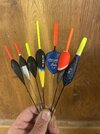In my experience, a Bolo float could have any body shape and any type of stem (but probably not wood). The only real defining feature being a longer sight tip between 1 and 4mm in diameter. However, even that isn't set in stone. They are rather more like a pole float on steroids. There's as much variation in Bolo floats as there is with Avons, there's no set pattern for either type. However, proper Italian Bolo fishing looks rather like running water pole fishing. The pole swapped out for a very long telescopic "pole" with rings and a reel fitted instead of elastic.
Which size Bolo, body shape, stem type and tip size you might use largely depends on the bait size, depth and pace of the water being fished. I've been misusing Bolo floats for years. I rarely fish the relatively deep rivers that Italian Bolo fishing came from. However, I'm quite happy using them on faster, shallower rivers (largely for grayling). The only thing I usually do to adapt them for my use is shorten the stem a little. When I do head to bigger, slower, deeper rivers, I may well use Bolo floats with longer stems, different shape bodies and larger capacities.


